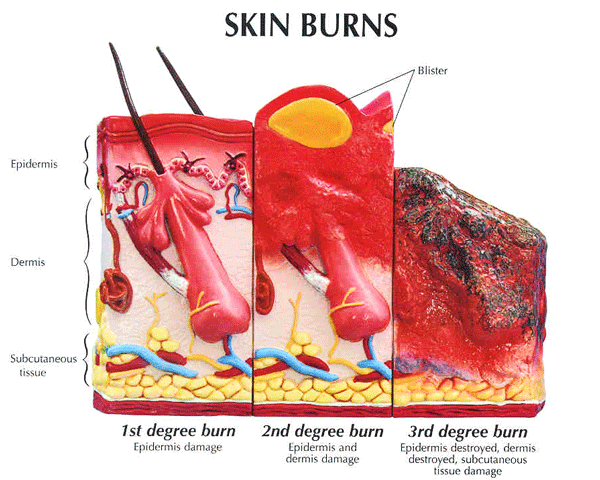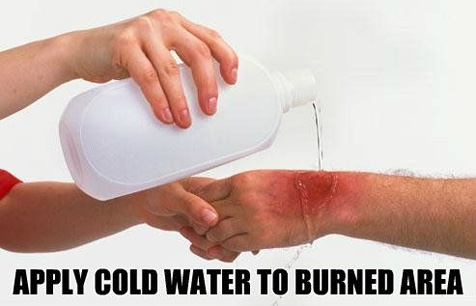There is something beautiful about fire that makes you want to touch it. However, we all know that doing so would hurt you. So what do you do when you are burnt? Should you drink medicine for cough and colds to ease the pain? Should you listen to the old wives’ tale and apply butter to the area? Before treating the burn, discover what type and what degree of burn it is.
TYPES OF BURNS
Thermal Burns
Thermal burns are caused by external heat sources such as fire or boiling water.
Chemical Burns
Chemical burns are caused by acids, alkali substances, solvents or detergents.
Electric Burns
Electrical burns are caused by electrical current, either AC or DC current.
Radiation Burn
Radiation burns are caused by extended exposure to alpha, betta or gamma radiation like the sun’s ultraviolet rays.
DEGREES OF BURNS

Burn degrees determine how thick a burn is. Here are the four degrees.
First Degree
First degree burns occur when only the skin’s outer layer or epidermis is burned. The area will be very red and painful with some swelling. The person may also feel a bit feverish. Sunburns are classified as first degree burns.
Second Degree
Second degree burns are burns that affect the skin’s inner layer or the dermis. A second degree burn can have two appearances. The first will be red, blistered with swelling that can last for 48 hours. The second will have the skin white when touched and the burned area will feel moist. Both appearances are very painful and be wary of possible infection with both cases.
Third Degree
Third degree burns are deep burns that hurt all the layers of the skin and the fatty tissue beneath it. These burns will affect the growth of the skin as the skin may not grow back the way it used to. The skin will feel leather like with a white, red or black color. If the damage is severe, the person may feel no pain at all as the nerve endings will be damaged.
Fourth Degree Burns
Fourth degree burns extend beyond the skin and fatty tissue.
FIRST AID TREATMENT

- Minor burns are qualified as first degree burns to second degree burns no bigger than 3 inches. If it is a major burn, immediately call for medical assistance. If the burn is chemical, electrical or radiation caused, call for medical assistance especially if you do not know what chemical caused the burn.
- Check the ABC- Airway, Breathing and Circulation If help is needed, do chest compressions, airway, breathing or CAB.
- Cut away as much clothing as possible. If it is stuck to the skin, do not forcibly remove it as doing so may cause further injury.
- Cool the area by holding it under running water for 10-15 minutes or covering it with a cool, wet cloth. Do not use cold water as this can induce shock or hypothermia.
- If blisters have developed, do not break them. If the blisters break, clean it with soap and water then dab on some antibiotic cream or ointment
- Remove jewelry, belts and other accessories as the burn may swell.
- Elevate the injured area above the heart if possible.
- Protect the burned person from further harm. If you can do so safely, make sure the person you're helping is not in contact with smoldering materials or exposed to smoke or heat. But don't remove burned clothing stuck to the skin.
- If it is a minor burn, do not apply butter as the old wives’ tale says but instead, apply burn ointment.
- Protect the burn by covering it with a clean, damp bandage or a clean cloth.
- Take pain relievers such as ibuprofen if the pain is too much.
You can prevent fire or burns by keeping chemicals out of children’s reach, making sure that there are no exposed wires on your appliances, and being careful with flammable devices and gas using equipment like your stove. Buy a fire extinguisher and keep it near your stove and change your smoke detector’s battery every 10 years. Remember, do not hesitate to call for medical help as delaying it may cause complications or death.